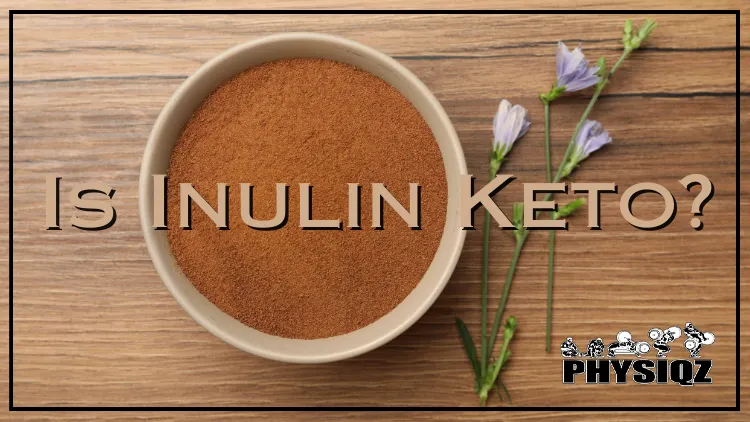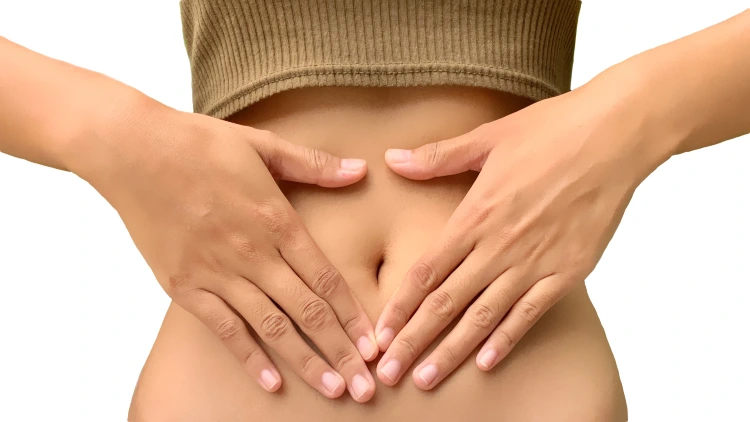
Inulin, keto friendly and highly encouraged on the ketogenic diet, is classified as a dietary fiber.1 More specifically, inulin is a naturally occurring polysaccharide (long chain carb) produced by many plant types, most prominently chicory root.
One may be surprised to learn that the average American consumes 10-15 grams of inulin per day–often without realizing–because it is in so many commonly eaten foods.
Therefore, yes, inulin is keto-approved, but it comes with an incredibly wide range of both benefits and potential side effects, making it all the more important for one to become familiar with it so they can decide for themselves whether or not to further incorporate it into their diet.
Does Inulin Have Any Carbs? How Many Carbs in Inulin?
Luckily for keto dieters, inulin is completely free of carbs.2
Oddly enough, inulin itself is a form of carbohydrate–a natural storage carbohydrate–but since net carbs are calculated by subtracting fiber content and any sugar alcohols from a food’s total carb count, the fiber in inulin completely cancels out the carbs to come out to zero carbs in pure inulin.
Is Inulin Keto Friendly?
Keto is the name of the game when it comes to inulin; and with no net carbs whatsoever and being composed of completely indigestible, soluble fibers, inulin does not have any negative impact to those following the keto low carb diet and has no chance of kicking someone out of ketosis; or in other words, inulin is very keto friendly.
Inulin & Keto (Carbs & Glycemic Index Ranking)
Keto, one of many currently trending diets, requires those following it to restrict their carb intake to just 20-50 grams per day. We’ve already established that inulin and keto go together amazingly well for this reason, but other factors can play a role in maintaining ketosis as well.
Specifically, someone on keto will want to make sure the foods and drinks they’re consuming fall low on the glycemic index (GI), a rating system for carb-containing foods. The GI essentially gives a representation of how quickly particular foods influence blood glucose after consumption.
Since inulin has zero net carbs and a GI rating of zero, it is completely keto approved.
Baking Keto Recipes With Inulin
Inulin has many impressive qualities that make it extremely versatile, but one key function is its usefulness in baking. Inulin allows for keto-friendly baked goods can be made due to the lower carbs; inulin can serve as a replacement for sugars or fats.
It can also be used in place of high carb flours. One carb-loaded example is cassava flour; keto-friendly inulin can be easily swapped in and drastically lower the carb load, in the form of inulin powder.
Additionally, rising keto bread with inulin is highly recommended. By adding inulin, yeast is more activated and rises better than without.

Source: Elena Leya from Unsplash3
Baking keto recipes with inulin is also ideal when a sugar-free or flour-free recipe needs a little sweetening, as inulin has a subtly sweet flavor without the added carbs or sugar. It’s also grouped with prebiotics due to its impact on gut health, an added reason to use inulin in future recipes.
Aside from baked goods, inulin can be added to tea, coffee, smoothies, yogurts, drinks, oatmeal, and more. It’s often used in ice cream to get rid of ice crystals and reduce the overall fat content.
Keto Substitute for Inulin
Inulin can be consumed in countless whole foods and is more common than one may expect. It can also be found in supplements in the form of powder, capsules, tablets, gummies, and more.
For those who are curious or have sensitivity to inulin, alternatives of keto include:
Monk Fruit: Monk fruit and monk fruit extract are incredibly keto-friendly due to the zero carb count. Up to 200 times sweeter than sugar, monk fruit is calorie and carb-free and very versatile in its uses.
Splenda: Splenda consists of dextrose and maltodextrin, as well as a very small amount of sucrose. With just 1g net carbs per packet, Splenda still falls low on the glycemic index and is keto compliant.
Stevia: Stevia is fully acceptable on keto with zero carbs, no artificial ingredients, and a glycemic index of zero. It can be a great sweetener for tea, coffee, sweets, and baked goods but be careful not to use too much as stevia tastes up to 300 times sweeter than regular table sugar.
Truvia: Whether in granulated or liquid form, Truvia sweetener is ketogenic, extremely low on the glycemic index, and contains only 2 grams of net carbs per half teaspoon serving.
Xylitol: A type of sugar alcohol often found in chewing gum and candy, xylitol has a similar taste and sweetness to sugar but has only 4g net carbs per teaspoon serving.
Although each of these are acceptable as a keto substitute for inulin, pure inulin is better for most people (who don’t have a negative reaction to it) because it is natural and aids in gut health and digestion, which artificial sweeteners do not.
How To Increase Fiber With Inulin (Sources of Inulin)
Anyone seeking ways to integrate more fiber into their diet should look into inulin, an excellent source of fiber weighing in at a whopping 9 grams per tablespoon of inulin. While concentrated supplements are widely available and touched on below, they are likely unnecessary since natural and healthier sources of inulin abound.
Let’s jump into ways to increase fiber with inulin.
Buy Concentrated Inulin Supplements
As mentioned, inulin supplements tend to be extremely processed and refined, making them much less “natural” and more likely to cause unpleasant side effects or even long term health issues. However, many swear by such supplements so if one chooses to give these supplements the trial and error method, they should do so with caution to measure their individual sensitivity before taking large or frequent doses.
Diffuse Chicory Roots in Hot Water
To extract inulin from chicory root, soak the roots in hot water and then refine and spray-dry the remaining concentrate.4 This is done most frequently in industrial settings and is often assisted by acid hydrolysis.

Source: David Will via Pixabay5
Eat Naturally Inulin-Rich Foods (Fruits, Vegetables & Herbs)
An abundance of foods naturally contain inulin, but several healthy options to choose from include:
- Agave
- Asparagus
- Banana
- Barley
- Dandelion Root
- Echinacea
- Garlic
- Hyacinth
- Jerusalem Artichoke
- Jicama
- Leeks
- Oat Root
- Onion
- Plantains
- Raisins
- Rye
- Soy Beans
- Wheat
- Wild Yams
- Yacon Root
Benefits of Inulin & Fiber
Inulin fiber is high in antioxidants and has an array of incredible properties and medicinal qualities. Functional and therapeutic potential of inulin includes improvement of gut flora, intestinal and digestive health, and even aiding in mental health due to the correlation between a healthy gastrointestinal tract and overall well-being.6
As far as fiber goes, there are two types: soluble and insoluble. Though both are vital to digestion, health, and disease prevention, soluble fiber attracts water and becomes gel while being digested.
It gives one’s stool more bulk, while insoluble fiber expedites food transport through the digestive tract to reduce the likelihood of constipation. Inulin is a type of soluble fiber, so it dissolves in liquid and becomes gel during digestion.
If incorporated into one’s diet, inulin soluble fiber can help one feel fuller for longer and serve as an effective appetite suppressant, therefore being useful in weight loss and in ways to hack hunger while fasting.
Replacement of glycaemic carbohydrates by inulin-type fructans from chicory (oligofructose, inulin) reduces the postprandial blood glucose and insulin response to foods and is therefore an incredible integration into a diabetic diet.7 Seemingly endless, other inulin fiber benefits include the following:
- Improves intestinal and digestive health
- Boosts heart health
- Suppresses appetite and can aid in weight loss
- Stimulates bowel movements and relieves constipation
- Improves colon health and reduces risk of colon cancer
- Stabilizes blood glucose levels
- Lowers cholesterol
- Increases the nutritional value of processed foods
- Elevates calcium absorption
- Stimulates good gut bacteria
- Fights infection and bad bacteria
- Increases bone health
- Reduces pain and stiffness due to osteoarthritis
- Repairs the gut microbiome (namely from damage due to Type 2 diabetes and gastrointestinal disease)
Potential Side Effects of Excessive Inulin & Chicory Root
Though inulin is known for its usefulness in digestive health, it is classified as a FODMAP and in rare cases some people can have negative reactions to inulin and it may cause the opposite effect of what it is meant to. Instead of promoting regularity and digestion, in these unique cases it can lead to issues such as intestinal and abdominal discomfort, flatulence, cramping, blockage, diarrhea, or loose stools.

Source: Alicia Harper from Pixabay8
This is most common in people who suffer from extreme stomach sensitivity, irritable bowel syndrome (IBS), or an inflammatory bowel disease (IBD).
Such reactions could alternatively be due to a chicory allergy, and those allergic to ragweed, daisies, chamomile, and pollen are more susceptible so should avoid or use great caution if taking concentrated inulin supplements as it could even cause a skin reaction if it comes into contact with one’s hands or other areas.
Note: Native inulin will likely have fewer if any side effects due to lack of chemical alterations and modifications
Who Should Avoid Inulin?
Those who are pregnant should avoid inulin due to a slight potential risk of miscarriage, but others who should consult a doctor first include those with digestive issues, IBS, IBD, sensitive stomach, and allergies to certain plants and pollens, as there is a common crossover to chicory root allergies.
Those with any of the aforementioned issues or sensitivities could suffer worsened digestive issues or discomfort if they consume or even come into contact with inulin, but this is extremely rare.
If someone is in doubt about whether or not increasing inulin consumption is right for them, they should start slowly and add just a little to their diet at a time to measure sensitivity.
Everyone should avoid the highly processed and refined version of inulin often found in supplements as it can cause more harm than good and is not needed to get sufficient inulin; for those who prefer supplements, seek pure organic 100% inulin online or in most grocery stores.
With inulin, keto compliance is far from the only positive trait for those wanting to incorporate it into a healthy diet; playing many roles from inulin flour to inulin sweetener, easily incorporated into weight loss diets to help lose inches overnight, and even used to lower cholesterol and boost heart health, this low carb plant fiber has a multitude of health benefits and is essential to digestive health.
Frequently Asked Questions
How Is Inulin Taken or Consumed?
Those curious about how inulin is taken or consumed may be pleased to discover that it can be found in many forms including capsules, gummies, tablets, chewables, and powder and online or in many grocery and drugstores.
What Can Inulin Be Found In?
Inulin is primarily extracted from the root of the chicory, but can be found in many fruits, vegetables, wheat, and other sources.
Is Inulin Safe for Diabetics?
Inulin, safe for diabetics, is actually highly encouraged on any diabetic diet as it improves blood glucose control and balance in those with prediabetes and diabetes, and can even aid in reversal of Type 2 diabetes.
References
1Africa Images. “Bowl of Chicory Powder and Flowers on Wooden Table, Flat Lay.” Canva. Accessed 9 April 2023. <https://www.canva.com/photos/MAFSoKoQzc8-bowl-of-chicory-powder-and-flowers-on-wooden-table-flat-lay/>
2Wikipedia the Free Encyclopedia. (2023, February 6). Inulin. Wikipedia. Retrieved February 8, 2023, from <https://en.wikipedia.org/wiki/Inulin>
3Elena Leya. “Free Cake.” Unsplash, 15 November 2021. Accessed 9 April 2023. <https://unsplash.com/photos/mr8yc2WyobI>
4Wikipedia the Free Encyclopedia. (2023, January 22). Chicory. Wikipedia. Retrieved February 8, 2023, from <https://en.wikipedia.org/wiki/Chicory>
5Will, David. “Chicory Roots Vegetables – Free photo on Pixabay.” Pixabay, 15 November 2017. Accessed 9 April 2023. <https://pixabay.com/photos/chicory-chicory-roots-vegetables-2945438/>
6Ahmed, W., & Rashid, S. (2019). Functional and therapeutic potential of inulin: A comprehensive review. National Institute of Health. Retrieved February 8, 2023, from <https://pubmed.ncbi.nlm.nih.gov/28799777/>
7Lightowler, H., Thondre, S., Holz, A., & Theis, S. (2018, April). Replacement of glycaemic carbohydrates by inulin-type fructans from chicory (oligofructose, inulin) reduces the postprandial blood glucose and insulin response to foods: report of two double-blind, randomized, controlled trials. National Institute of Health. Retrieved February 8, 2023, from <https://pubmed.ncbi.nlm.nih.gov/28255654/>
8Harper, Alicia. “Ibs Probiotic Gut – Free photo on Pixabay.” Pixabay, 17 June 2020. Accessed 9 April 2023. <https://pixabay.com/photos/ibs-probiotic-gut-stomach-colon-5308379/>